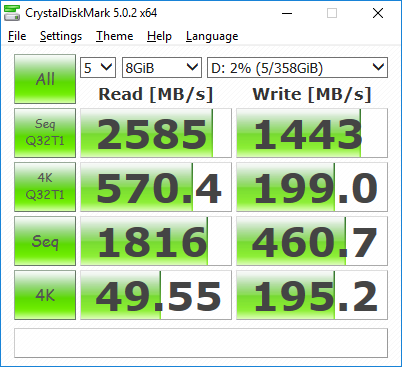ASRock Beebox-S 6200U Review - An Alternative to the Skylake NUC
by Ganesh T S on August 10, 2016 8:00 AM ESTNetworking and Storage Performance
Networking and storage are two major aspects which influence our experience with any computing system. This section presents results from our evaluation of these aspects in the ASRock Beebox-S 6200U.
One of the interesting aspects of the Skylake-U platform is the bandwidth available for communication between the CPU and the PCH inside the Skylake-U package. By default, Intel ships them optimized for low power consumption (effectvely four lanes of PCIe 2.0 bandwidth). However, its customers can optimize for higher performance (effectively four lanes of PCIe 3.0 bandwidth) depending on the end system in which the Skylake-U SiP gets deployed. We covered this in detail in our article on choosing the right M.2 SSD for the NUC6i5SYK.
ASRock has configured the Core i5-6200U for hgher performance in the Beebox-S 6200U. Our quick check for this involved running the CrystalDiskMark benchmark on the Samsung SSD 950 PRO after installing it in the Beebox-S 6200U. We can see that the M.2 PCIe SSD is able to meet its full claimed performance numbers (possible only with a PCIe 3.0 x4 link).
In order to further evaluate storage performance, one option would be repetition of our strenuous SSD review tests on the drive(s) in the PC. Fortunately, to avoid that overkill, PCMark 8 has a storage bench where certain common workloads such as loading games and document processing are replayed on the target drive. Results are presented in two forms, one being a benchmark number and the other, a bandwidth figure. We ran the PCMark 8 storage bench on selected PCs and the results are presented below.


Thanks to ASRock's attention to the OPI link rate in the Core i5-6200U, the storage benchmarks show the Beebox-S 6200U come out in the top half of the list.
On the networking side, we restricted ourselves to the evaluation of the WLAN component. Our standard test router is the Netgear R7000 Nighthawk configured with both 2.4 GHz and 5 GHz networks. The router is placed approximately 20 ft. away, separated by a drywall (as in a typical US building). A wired client is connected to the R7000 and serves as one endpoint for iperf evaluation. The PC under test is made to connect to either the 5 GHz (preferred) or 2.4 GHz SSID and iperf tests are conducted for both TCP and UDP transfers. It is ensured that the PC under test is the only wireless client for the Netgear R7000. We evaluate total throughput for up to 32 simultaneous TCP connections using iperf and present the highest number in the graph below.

In the UDP case, we try to transfer data at the highest rate possible for which we get less than 1% packet loss.

The Beebox-S has very good antenna placement, and make it come out on top when other PCs that have 1x1 configurations are considered. However, mini-PCs that have 2x2 802.11ac WLAN chipsets obviously perform better than the Beebox-S 6200U.











30 Comments
View All Comments
dsraa - Wednesday, August 10, 2016 - link
You're right, the link for newegg is a barebones unit for $319. Doesnt include anything.Ro_Ja - Wednesday, August 10, 2016 - link
Heh...We're talking about the NUC with the Skylake :)Ro_Ja - Wednesday, August 10, 2016 - link
The NUC's also good enough for gaming if you're not the type of maxing everything out at 1080P.vailr - Wednesday, August 10, 2016 - link
I think they stole the name from Jean-Louis Gassée:https://en.wikipedia.org/wiki/BeBox
hojnikb - Thursday, August 11, 2016 - link
> you would also be getting Intel QC.You means that "famous" intel QC, where they had to release numerous bios updates before the thing became useful ?
Samus - Wednesday, August 10, 2016 - link
My only complaint is they cut costs using the Intel 3160 instead of the Intel 8260 (or even the older Intel 7260) which is ridiculous when you consider the 3160 and last-gen 7260 are virtually the same price.But at least they didn't use a 802.11n card. I can't believe how many of those I still see even in $1000 Thinkpad's and Elitebook's. Literally talking a few dollars in difference for improved range, performance and battery life going from 1x1 to 2x2.
u.of.ipod - Wednesday, August 10, 2016 - link
I would love to see a review of the newest generation (and revision) of the Gigabyte Brix. The newest revisions have USB 3.1 (type c) ports and DDR4 RAM in addition to the Skylake CPUsganeshts - Wednesday, August 10, 2016 - link
I have it in the queue, but I am waiting for a BIOS update : http://www.gigabyte.com/products/product-page.aspx... : Intel has made a bunch of fixes in the Skylake-U platform that are BIOS-related, and I want to evaluate with the most stable / recent platform Until GIGABYTE updates their BIOS with the fixes from Intel, I am not going to recommend the Skylake BRIX units.tipoo - Wednesday, August 10, 2016 - link
Still fixing it this long after Skylakes launch eh. What a mess. Kind of puts into perspective why there's no Macbook Pros with Skylake yet.u.of.ipod - Saturday, August 13, 2016 - link
Oh I didn't know there were problems with the Skylake BRIX units, I'll have to go re-read the Anandtech review.I just put together a simple Skylake BRIX i3 (the DDR3L version) for a friend using all open box parts from amazon. Seems to be humming right along for HTPC and emulator duties. I was considering upgrading my existing HTPC with one of the DDR4/USB C versions.